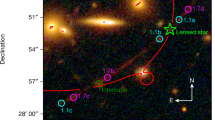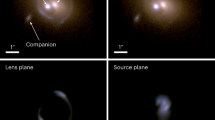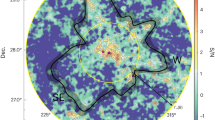Abstract
A galaxy can act as a gravitational lens, producing multiple images of a background object. Theory predicts that there should be an odd number of images produced by the lens1,2, but hitherto almost all lensed objects have two or four images. The missing ‘central’ images, which should be faint and appear near the centre of the lensing galaxy, have long been sought as probes of galactic cores too distant to resolve with ordinary observations3,4,5,6,7. There are five candidates for central images, but in one case the third image is not necessarily the central one8,9,10, and in the others the putative central images might be foreground sources11,12,13,14,15. Here we report a secure identification of a central image, based on radio observations of one of the candidates14. Lens models using the central image reveal that the massive black hole at the centre of the lensing galaxy has a mass of <2 × 108 solar masses (M⊙), and the galaxy's surface density at the location of the central image is > 20,000M⊙ pc-2, which is in agreement with expections based on observations of galaxies that are much closer to the Earth.
This is a preview of subscription content, access via your institution
Access options
Subscribe to this journal
Receive 51 print issues and online access
$199.00 per year
only $3.90 per issue
Buy this article
- Purchase on Springer Link
- Instant access to full article PDF
Prices may be subject to local taxes which are calculated during checkout


Similar content being viewed by others
References
Dyer, C. C. & Roeder, R. C. Possible multiple imaging by spherical galaxies. Astrophys. J. 238, L67–L70 (1980)
Burke, W. L. Multiple gravitational imaging by distributed masses. Astrophys. J. 244, L1 (1981)
Narasimha, D., Subramanian, K. & Chitre, S. M. “Missing image” in gravitational lens systems? Nature 321, 45–46 (1986)
Wallington, S. & Narayan, R. The influence of core radius on gravitational lensing by elliptical lenses. Astrophys. J. 403, 517–529 (1993)
Rusin, D. & Ma, C.-P. Constraints on the inner mass profiles of lensing galaxies from missing odd images. Astrophys. J. 549, L33–L37 (2001)
Evans, N. W. & Hunter, C. Lensing properties of cored galaxy models. Astrophys. J. 575, 68–86 (2002)
Keeton, C. R. Lensing and the centers of distant early-type galaxies. Astrophys. J. 582, 17–29 (2003)
Muñoz, J. A., Kochanek, C. S. & Keeton, C. R. Cusped mass models of gravitational lenses. Astrophys. J. 558, 657–665 (2001)
Lewis, G. F., Carilli, C., Papadopoulos, P. & Ivison, R. J. Resolved nuclear CO(1–0) emission in APM 08279 + 5255: gravitational lensing by a naked cusp? Mon. Not. R. Astron. Soc. 330, L15–L18 (2002)
Lewis, G. F. et al. Spatially resolved STIS spectra of the gravitationally lensed broad absorption line quasar APM082791 + 5255: the nature of component C and evidence for microlensing. Mon. Not. R. Astron. Soc. 334, L7–L10 (2002)
Gorenstein, M. V. et al. Detection of a compact radio source near the center of a gravitational lens: quasar image or galactic core? Science 219, 54–56 (1983)
Chen, G. & Hewitt, J. N. Multifrequency radio images of the Einstein ring gravitational lens MG 1131 + 0456. Astrophys. J. 106, 1719–1728 (1993)
Fassnacht, C. et al. B2045 + 265: A new four-image gravitational lens from CLASS. Astron. J. 117, 658–670 (1999)
Winn, J. N. et al. PMN J1632–0033: a new gravitationally lensed quasar. Astron. J. 123, 10–19 (2002)
Winn, J. N., Rusin, D. & Kochanek, C. S. Investigation of the possible third image and mass models of the gravitational lens PMN J1632–0033. Astrophys. J. 587, 80–89 (2003)
Winn, J. N., Kochanek, C. S., Keeton, C. R. & Lovell, J. E. J. The quintuple quasar: radio and optical observations. Astrophys. J. 590, 26–38 (2003)
Keeton, C. R. & Winn, J. N. The quintuple quasar: mass modeling and interpretation. Astrophys. J. 590, 39–51 (2003)
Narayan, R., Blandford, R. & Nityananda, R. Multiple imaging of quasars by galaxies and clusters. Nature 310, 112–115 (1984)
Subramanian, K., Chitre, S. M. & Narasimha, D. Minilensing of multiply imaged quasars: flux variations and vanishing of images. Astrophys. J. 289, 37–51 (1985)
Faber, S. et al. The centers of early-type galaxies with HST. IV. Central parameter relations. Astron. J. 114, 1771–1796 (1997)
Mao, S., Witt, H. J. & Koopmans, L. V. E. The influence of central black holes on gravitational lenses. Mon. Not. R. Astron. Soc. 323, 301–307 (2001)
Ferrarese, L. & Merritt, D. A fundamental relation between supermassive black holes and their host galaxies. Astrophys. J. 539, L9–L12 (2000)
Gebhardt, K. et al. A relationship between nuclear black hole mass and galaxy velocity dispersion. Astrophys. J. 539, L13–L16 (2000)
Tremaine, S. et al. The slope of the black hole mass versus velocity dispersion correlation. Astrophys. J. 574, 740–753 (2002)
Mezger, P. G. & Henderson, A. P. Galactic H ii regions I. Observations of their continuum radiation at the frequency 5 GHz. Astrophys. J. 147, 471–489 (1967)
Beckert, T. et al. Anatomy of the Sagittarius A complex. V. Interpolation of the Sgr A* spectrum. Astron. Astrophys. 307, 450–458 (1996)
Taylor, G. B. The symmetric parsec-scale jets of the radio galaxy Hydra A. Astrophys. J. 470, 394–402 (1996)
Walker, R. C. et al. VLBA absorption imaging of ionized gas associated with the accretion disk in NGC 1275. Astrophys. J. 530, 233–244 (2000)
Sheperd, M. C. in Astronomical Data Analysis Software and Systems VI (eds Hunt, G. & Payne, H.E.) 77–84 (ASP Conf. Ser. 125, ASP, San Francisco, 1997)
Acknowledgements
We thank S. Doeleman, D. Harris and P. Schechter for discussions, and J. Bullock for comments on the manuscript. J.N.W. acknowledges the support of the National Science Foundation (NSF) through an Astronomy and Astrophysics Postdoctoral Fellowship. The VLA is part of the National Radio Astronomy Observatory, an NSF facility operated under cooperative agreement by Associated Universities, Inc.
Author information
Authors and Affiliations
Corresponding author
Ethics declarations
Competing interests
The authors declare that they have no competing financial interests.
Rights and permissions
About this article
Cite this article
Winn, J., Rusin, D. & Kochanek, C. The central image of a gravitationally lensed quasar. Nature 427, 613–615 (2004). https://doi.org/10.1038/nature02279
Received:
Accepted:
Issue Date:
DOI: https://doi.org/10.1038/nature02279
Comments
By submitting a comment you agree to abide by our Terms and Community Guidelines. If you find something abusive or that does not comply with our terms or guidelines please flag it as inappropriate.



